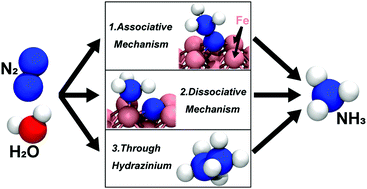Meteorite impacts on ancient oceans opened up multiple NH3 production pathways†
Abstract
A recent series of shock experiments by Nakazawa et al. starting in 2005 (e.g. [Nakazawa et al., Earth Planet. Sci. Lett., 2005, 235, 356]) suggested that meteorite impacts on ancient oceans would have yielded a considerable amount of NH3 to the early Earth from atmospheric N2 and oceanic H2O through reduction by meteoritic iron. To clarify the mechanisms, we imitated the impact events by performing multi-scale shock technique-based ab initio molecular dynamics in the framework of density functional theory in combination with multi-scale shock technique (MSST) simulations. Our previous simulations with impact energies close to that of the experiments revealed picosecond-order rapid NH3 production during shock compression [Shimamura et al., Sci. Rep., 2016, 6, 38952]. It was also shown that the reduction of N2 took place with an associative mechanism as seen in the catalysis of nitrogenase enzymes. In this study, we performed an MSST-AIMD simulation to investigate the production by meteorite impacts with higher energies, which are closer to the expected values on the early Earth. It was found that the amount of NH3 produced further increased. We also found that the increased NH3 production is due to the emergence of multiple reaction mechanisms at increased impact energies. We elucidated that the reduction of N2 was not only attributed to the associative mechanism but also to a dissociative mechanism as seen in the Haber–Bosch process and to a mechanism through a hydrazinium ion. The emergence of these multiple production mechanisms capable of providing a large amount of NH3 would support the suggestions from recent experiments much more strongly than was previously believed, i.e., shock-induced NH3 production played a key role in the origin of life on Earth.



 Please wait while we load your content...
Please wait while we load your content...